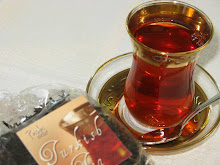
Throughout history the tulip and arabesque motifs have had multiple meanings. We know that the tulip was used as a heraldic symbol at the height of the Ottoman Empire. Almost any repetitive or geometric pattern falls under the arabesque category with the exception of human forms, taboo in the Islamic world. Islamic arabesque, whether geometric or undulating and repetitive vines, is a characteristic motif in Turkish ceramics, tiles, and carpets.
My certificate of authenticity that came with the plate from Firca (pottery factory built inside a cave) in Avanos states that it is family-designed art by Mustafa Cakir. The salesman told me that Mustafa, whom he identified as his brother, created this among his final pieces before he passed away a few years ago. I particularly like the juxtaposition of the contemporary tulips against the repetitive background. When I rub my hand across the plate, I feel the raised dots created with slip. With my limited knowledge of ceramics, I know that creating such an intricate pattern would require a steady hand, patience, and expert vision.

No comments:
Post a Comment